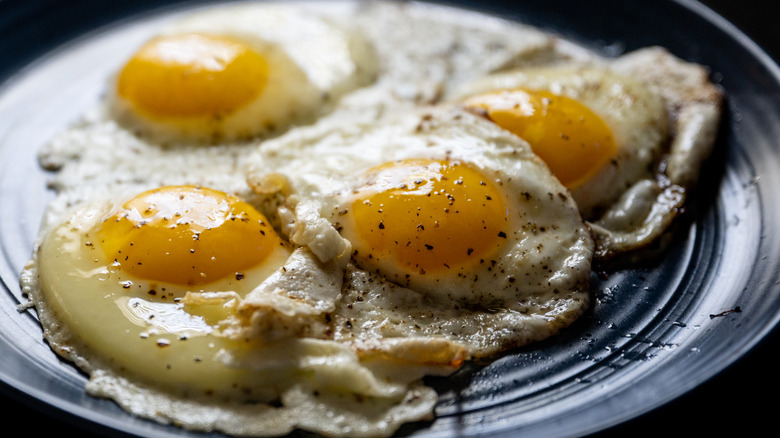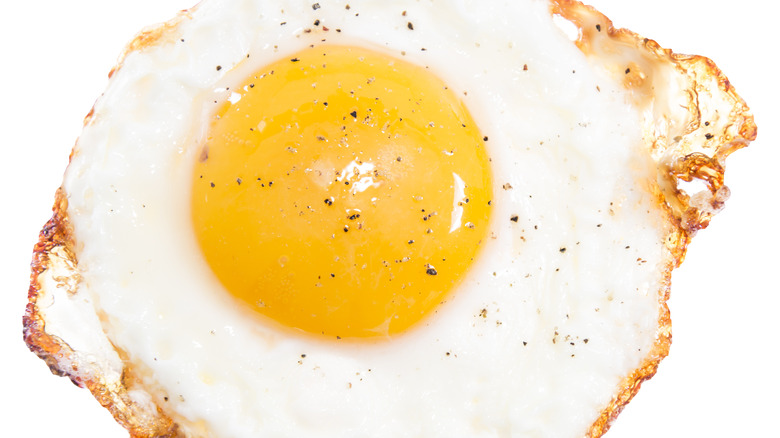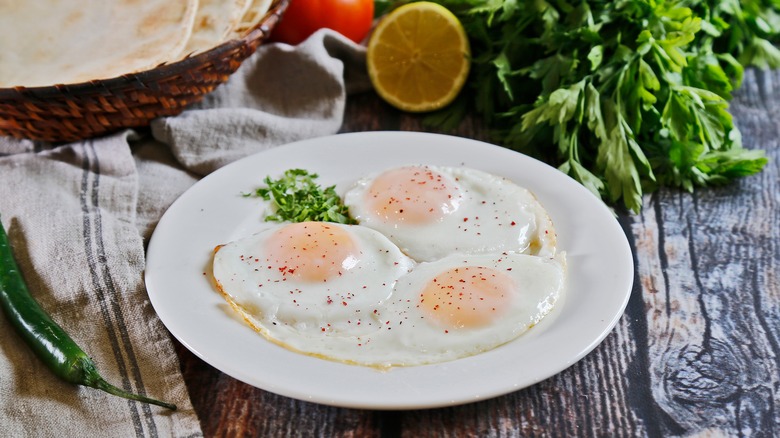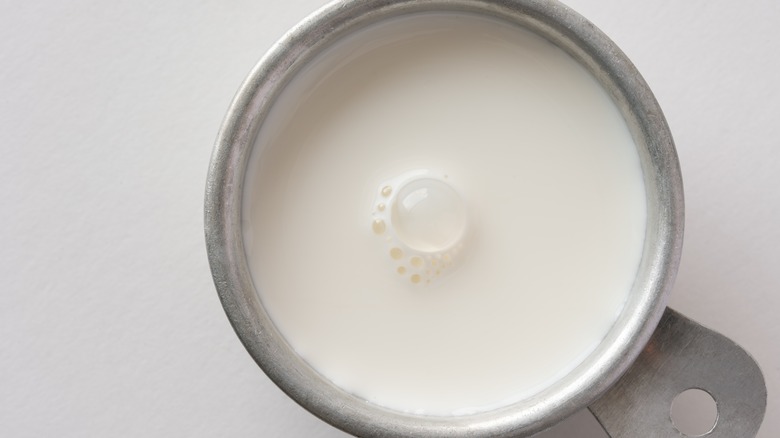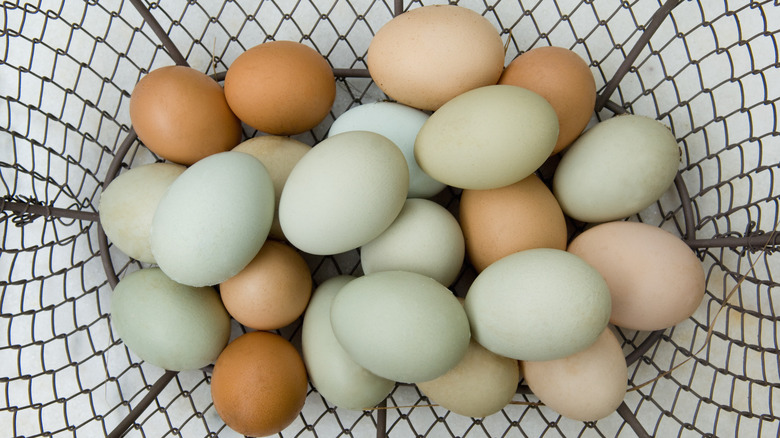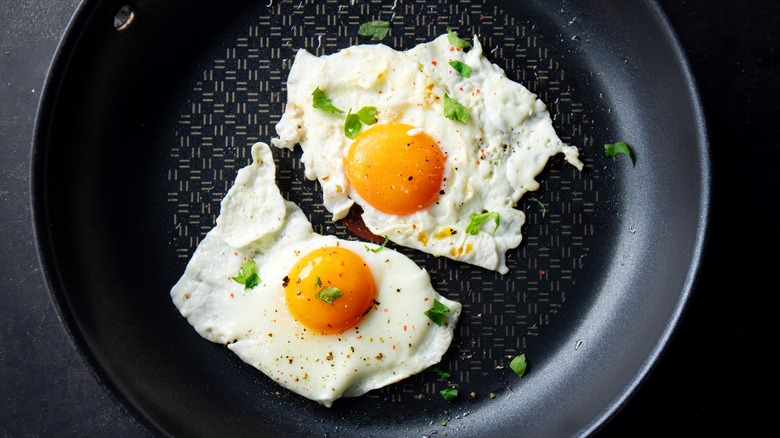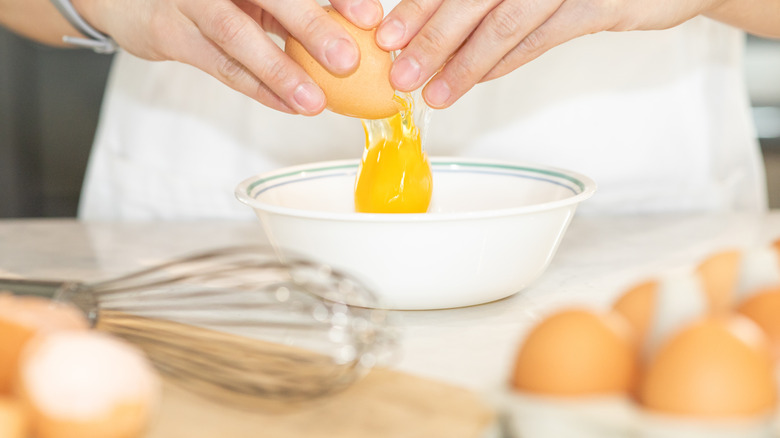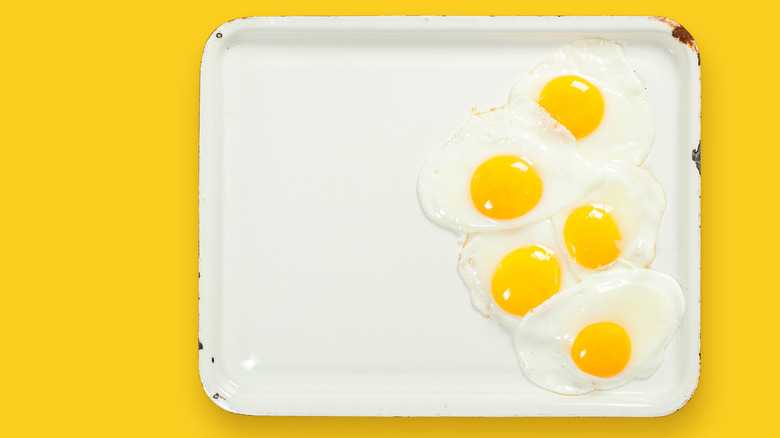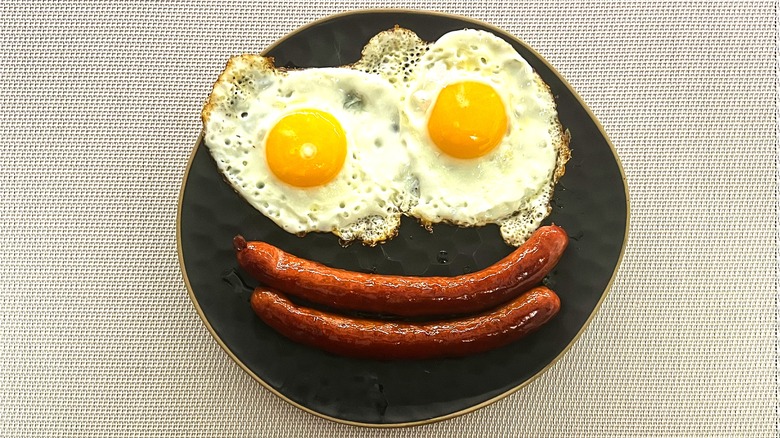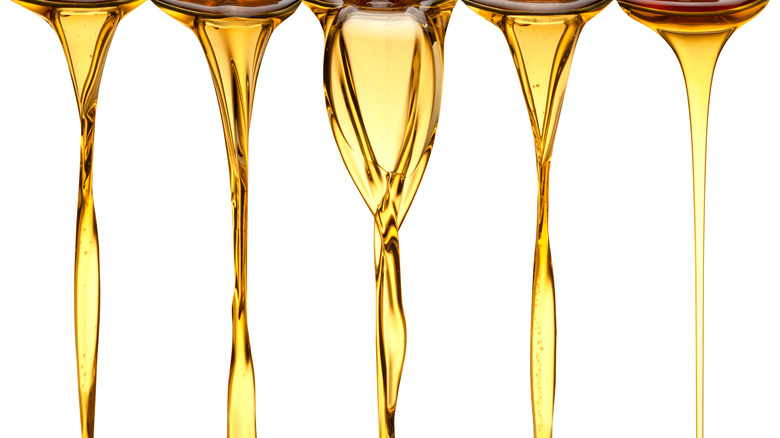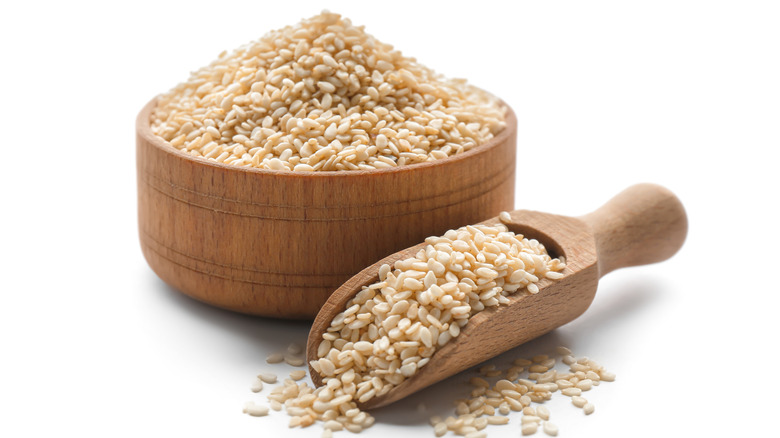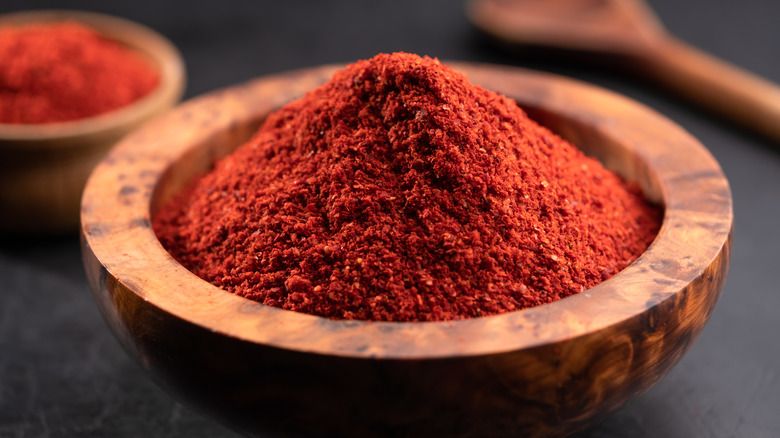11 Hacks For The Best Fried Eggs Of Your Life
Let's be clear: The best fried egg ever is whatever you say it is. There's no clear consensus on the right way to cook one up. Depending on who you ask, the best fried egg is either a stock-photo perfect round of tender white and yolk, a rustic preparation with a runny yolk and crispy brown edges, or a resilient round cooked hard on both sides. Thus, the best hacks for preparing a great fried egg will depend on what your idea of a great fried egg is.
Fortunately, no matter how you like your fried eggs, someone has done the hard work of figuring out how to make them even better. By simply changing out the cooking fat, cooking time, cooking method, or seasonings, you can fry eggs with a range of different looks, textures, and flavors. So whether you're seeking a go-to hack for frying eggs just the way you like them or want to mix up your routine a bit, the tips below will give you plenty of inspiration.
1. Use olive oil to get fried eggs with crispy brown edges
There are two basic schools of thought when it comes to the perfect texture for the whites of fried eggs. First, there are the purists who won't settle for anything other than a pristine, bright white that is cooked but tender all the way through. On the other side are those who like their fried eggs with a bit more personality, with lacy, browned, and above all, wonderfully crispy edges — think of it as a bit like having your eggs and toast all in a single bite.
If you're on team crispy edges, an easy hack to get the fried egg you desire every time is to fry your eggs in olive oil. According to Olive Oils from Spain, olive oil helps fried foods form a crusty layer that adds crunch and color while keeping the rest of the food from absorbing more oil. Furthermore, Olive Oils from Spain notes that olive oil's high smoke point means its flavor won't degrade when it's heated to frying temperature,
2. Cover your pan makes eggs easier to flip
For fans of over-easy fried eggs, the most perilous part of the cooking process is the flip. Get it right, and you'll have a perfect egg, cooked on the outside but with an intact, saucy yolk hidden within. Get it wrong — say, by breaking the yolk as you slip your spatula under the egg — and you'll end up with something more like a badly mixed scrambled egg. It'll still be edible, but it won't be pretty.
A big reason for this challenge is the yolk of a sunny-side up egg, which is basically what you have before you flip it to make an over-easy egg, is fragile and basically liquid. Thus, moving the egg around or putting pressure on it – as you must when flipping it — can very easily rupture the yolk. This means flipping the egg while keeping the yolk intact yet soft requires some strategy. And the strategy recommended by celebrity chef Michael Symon is simple and sensible: When frying your egg, simply put a lid on the pan for 20 to 30 seconds before flipping your egg. The steam formed under the lid will seal the surface of yolk, which will help keep it from breaking during the flip.
3. Fry your eggs in cream ror extra richness and flavor
Butter has long been the go-to frying medium for many fried egg lovers. Almost everyone have some in their refrigerator, and its richness makes it a perfect flavor match for fried eggs. Not to mention, who doesn't love the sound and smell of sizzling butter in a hot pan? But no matter how much you love your butter-fried eggs, it's good to mix things up from time to time. There's another, under-the-radar fried egg variation that is sure to please any butter lover – eggs fried in cream.
It's not as strange an idea as you might think. Butter, after all, is essentially cream with most of its liquid, proteins, and sugars removed. Thus, frying eggs in cream will give you all the buttery goodness and richness you love along with some extra flavor and caramelization. And it's just as easy to do as frying eggs in butter or other oils. According to blogger and cookbook author Lisa Steele at Fresh Eggs Daily, to fry eggs in cream, simply pour a thin layer of cream into the bottom of a cold pan and heat at medium-high until the cream starts to bubble around the edges. Slip in your eggs and continue cooking. The cream will separate and brown as the eggs cook, so watch the heat to prevent it from burning.
4. Use room temperature eggs for even cooking
One of the pitfalls of cooking eggs is that they sometimes seem to behave unpredictably. One day, your fried eggs will turn out evenly shaped and firm, and the next they'll turn out oddly shaped and runny. Any number of factors — the age and type of eggs you're using, the type of pan you're cooking in, and even how much attention you're paying when cooking – can make a big difference in how your eggs look and taste. Thus, if you're aiming to strengthen your fried egg game and train yourself to get them right every time, it's a good idea to target what works and do it consistently.
And a good practice to develop for making consistently good fried eggs is to use room temperature eggs. As chef Robert Irvine notes, eggs should not be cold when fried. When you fry an egg straight from the refrigerator, you risk overcooking the yolk by the time the whites are completely set (via The Guardian). And if you enjoy a runny yolk (for many, the best part of a fried egg), this is a nonstarter. But while it can take time for a cold egg to come to room temperature, you can still enjoy fried eggs as a last-minute, quick meal — just soak the cold eggs in warm tap water for five minutes before cooking.
5. A nonstick pan is always a good bet
Ask ten people what the perfect fried egg looks like, and it's possible you'll get ten different answers. But there are a few non-negotiable points all fried egg lovers can agree on: The whites and yolk must be distinct, and the egg must come out of the pan in one piece. Still, achieving even these modest goals isn't always as easy as it sounds, especially for novice cooks. Even a simple mistake such as under heating your pan can cause your eggs to become irretrievably stuck. This is because a typical stainless steel pan forms chemical bonds with the food it comes into contact with (per Science of Cooking). Oil, if sufficiently heated, prevents these bonds from forming by searing the food and releasing steam, which lifts the food off the metal surface.
A surefire way to prevent sticking — and make cleanup easier — is to fry your eggs in a nonstick pan. And to ensure your nonstick pan maintains its slippery surface, treat it gently. Better Homes and Gardens advises using only soft sponges and cloths with mild soap for cleaning (for stubbornly stuck-on food, soak the pan for a few hours). Furthermore, Better Homes and Gardens advises against using metal utensils or any utensils with sharp points or edges when cooking with these pans.
6. Never crack eggs directly into the pan
We've all heard the principle that simple solutions are always best. If you can do something in one step, why waste your time doing it in two or more steps? And while we can all agree that avoiding needless complexity is a good thing, there are times when taking that extra step — no matter how redundant it may initially seem — can actually yield better results.
Take the case of cracking eggs for fried eggs. A common approach is to simply crack the egg on the lip of the heated pan and pour it in — it's quick, it's easy, and it usually works. But according to master chef Jacques Pepin, it also runs the risk of breaking the yolk or mixing shell shards or bacteria from the shell into your egg. Instead, he recommends cracking the egg on a flat surface, such as a countertop, and using your thumbs to gently open the egg. In addition, celebrity chef Bobby Flay recommends cracking eggs into a small bowl or cup before pouring them into the frying pan (via Food Network). This will ensure you don't fry any eggs with broken yolks or that have gone bad.
7. When cooking for a crowd, fry your eggs in the oven
Fried eggs are a go-to dish for many home cooks because they're quick to make and almost everyone loves them. And like a classic little black dress, they're appropriate almost everywhere, from inside sandwiches, atop burgers or bowls of bibimbap, to simply on a plate with bacon and toast. But for many home cooks, the idea of making fried eggs for a large group makes us balk. Even the largest frying pan will only hold about half a dozen eggs at most, and trying to get a dozen or more eggs to cook consistently in different pans on different burners at the same time can be tricky and stressful.
Luckily, there's an easy way to make a large quantity of evenly fried eggs, and it doesn't even involve your stovetop. Bake up a batch of sheet pan fried eggs by thoroughly greasing a sheet pan with cooking spray, preheating it for ten minutes in a 475 F oven, then carefully pouring on your cracked eggs (a bowl with a pouring spout is useful for this step). Sprinkle the eggs with salt and pepper, then carefully transfer the sheet pan to the oven and bake for five minutes, or until the eggs are done to your preference. Once the eggs are cooked to your liking, immediately remove them from the sheet pan (otherwise they'll continue cooking) and serve them to your hungry friends.
8. Try basting for fully cooked sunny-side up eggs
Sunny-side up eggs are a classic example of culinary simplicity — they're nothing more than eggs (and maybe a little salt and pepper) slipped into a pan of hot fat and left to cook until the whites are firm but the yolks are warmed through and appealingly saucy. the end result is a thing of beauty — the contrast between the whites and the bright yellow yolk does indeed look sunny, and it tastes amazing to boot.
But simple isn't always the same thing as easy. While there are not many steps to making a sunny-side up egg, there are plenty of potential pitfalls. And one of them is the possibility of slimy, undercooked whites on the top side of the egg even after the underside the fully cooked. Luckily, a couple of easy hacks can help you avoid this problem. Try water-basting your eggs by pouring a small quantity of water into your cooking pan along with the eggs and spooning the hot water over the whites as they cook (via MasterClass). This cooks the tops of the eggs while keeping them moist. Oil-basting works the same way, but involves spooning the cooking fat over the whites instead (via Martha Stewart).
9. Leftover oils add surprising flavor to fried eggs while reducing waste
While fried eggs taste great on their own, one of the things that make them so appealing is how well they go with other foods and flavors. Not only do they pair well with other dishes, but they lend themselves to a multitude of different seasonings, from salt and pepper to hot sauce, and for some, even ketchup (yes, we see you!).
But another way to spice up the flavor of your fried egg is to change out your frying medium. It's no secret that butter, olive oil, and bacon fat — all popular choices for fried eggs — each contribute their own flavor and character to the finished dish, and all have their defenders for good reason. But creative cooks have been exploring less-expected options as well. An economical and fun option is to fry your eggs in the leftover oil from jarred marinated foods, such as artichokes, sun-dried tomatoes, red peppers, or even sardines, suggests a food writer from Bon Appétit. These oils are super flavorful and will not only add a distinct flavor to your eggs, but will serve as a built-in sauce, perfect for soaking up with a piece of toast. Not to mention, it's a great way to use up these oils, which typically get tossed once the jar is empty.
10. Fry your eggs with sesame seeds for a toasty crunch
Fans of fried eggs appreciate their tender texture and how nicely this contrasts with crispy accompaniments such as crusty toast or crunchy hash browns. And creative cooks love how easy it is to riff on a basic fried egg recipe — change out your frying oil or add a few new ingredients and your familiar fried egg takes on a whole new character. This next hack lends itself to amped up flavor and texture all in one.
Next time you're whipping up breakfast, give sesame fried eggs a try. Cookbook author Christine Anne Flynn makes them by warming butter in a frying pan, sprinkling in a generous quantity of sesame seeds, then cracking an egg on top of the seeds. She then sprinkles more seeds over the top of the egg before it sets. The finished egg comes out covered with toasted sesame seeds, adding visual flair along with crunch and flavor. To complete the recipe, Flynn serves her sesame eggs on toast smeared with labneh and a bit of harissa, but you can choose your own embellishments or just enjoy them as is.
11. Swirl paprika into your cooking fat for colorful, spicy fried eggs
Tasty as fried eggs are, some cooks and eaters find they look kind of plain. This is why many restaurant kitchens and home cooks like to garnish their fried eggs with something that will add a bit of color, such as a sprinkle of chopped parsley or paprika.
But don't think of these add-ons as merely cosmetic. Deployed differently, spices such as paprika can also transform your fried eggs into a completely different and more intriguing dish. Instead of just topping your finished fried eggs with a sprinkle of paprika, lean into its rich red color and distinctive flavor by making paprika fried eggs. To prepare them, heat olive oil in your frying pan and add a generous hit of paprika directly to the oil before adding your eggs. The paprika toasts in the oil, enhancing its flavor while creating a deep red sauce to spoon over the eggs. And you can spice up this recipe even more by varying the type of paprika you use (smoked, hot, or sweet) and adding additional garnishes — green herbs such as scallions or cilantro will make the paprika's red really pop.
